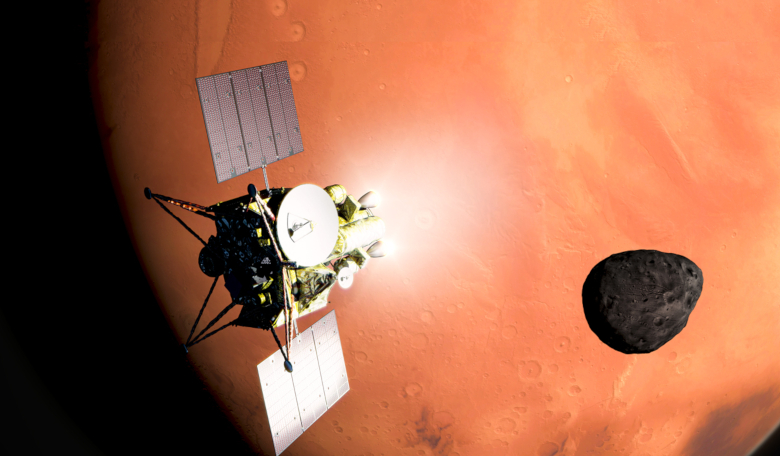JAXA’s Martian Moon eXploration (MMX) has been given the green light to proceed to the development phase from its previous Pre-Project phase status, paving the way forward for the agency to send a spacecraft to Mars' moon Phobos and to pluck a sample from its surface.
Having successfully ticked off a number of criteria in the last three years to have the project officially authorised by the Japanese government, such as finance and risk planning, the development of appropriate science goals and simulating landings to improve spacecraft designs, the MMX mission team will now move onto the development of mission hardware and software.
One of the mission’s main science goals is to understand how Mars formed. In recent years, the Red Planet has become a target for the development of a human outpost. The building of any base would benefit greatly if it was known what lay beneath the martian surface.
The inner rocky planets are thought to orbit too close to the Sun to have retained many volatiles during formation. Water for example is suspected to exist in large quantities hidden out of sight underground on Mars. But just how did it get its water? Did it arrive via comets and asteroids like many suspect it did on Earth?
Scientists will only be able to apply this reasoning to Mars, if it turns out Phobos and Deimos are actual chunks of Mars, ripped off during a giant impact with another body; the same process that was thought to create our moon.
It could be that Phobos and Deimos are two asteroids captured by Mars’s gravity as they were scattered inwards from the asteroid belt. This is a popular theory, but the jury is still out; JAXA hopes to answer this and other questions about Mars’ evolution, and in doing so boost our chances of successfully establishing colonies on our nearest planetary neighbour.
Phobos, which orbits closer to Mars has been deemed by the mission team to be the more scientifically desirable moon for sample collection than its smaller companion, as Phobos appears to be made up of two different compositions, that so far have been difficult to explain, while Deimos has only one.
Armed with a corer to extract material from the moon, the MMX spacecraft is planning to land for several hours on Phobos to collect a sample of at least 10 grams from a minimum of 2 centimetres below the moon’s surface. The spacecraft will then head back to Earth so the sample can be analysed by scientists.
This will be an advancement on the recent Japanese Hayabusa 2 mission which saw the spacecraft touch the asteroid surface only briefly to gather a minimal sample of 0.1 gram.
For their next mission the MMX team want to push the technology even further by showing it is possible to enter and leav Mars’s gravitational well, land and navigate on the surface of the orbiting low-gravity bodies and deploy equipment for tasks such as surface sampling.
This says JAXA, “will benefit future missions, including those aimed at sending a human crew to the red planet.”
“Humans can realistically explore the surfaces of only a few objects and Phobos and Deimos are on that list,” noted NASA Chief Scientist, Jim Green. “Their position orbiting about Mars may make them a prime target for humans to visit first before reaching the surface of the Red Planet, but that will only be possible after the results of the MMX mission have been completed.”
The MMX spacecraft is equipped with eleven instruments, four of which will be provided by international partners; NASA (USA) is contributing a gamma ray and neutron spectrometer, ESA (Europe) is listed as assisting with deep space communication equipment, CNES (France) is building a near-infrared spectrometer, while DLR (Germany) is to design the rover, which could explore the surface of Phobos.
In addition to the sampling device and sample return capsule, JAXA’s contributions include a LIDAR laser altimeter, a dust monitor and a mass spectrum analyser, to study the charged ions around the moons, a telescopic (narrow-angle) camera for observing detailed terrain and a wide-angle camera for identifying organic matter and hydrated minerals.
Implementing Arrangements have already been signed with the above agencies, which includes sharing experiment facilities and scientific expertise when the results of this mission to understand both how a habitable planet is born and how humans might explore beyond our own world start rolling in.











